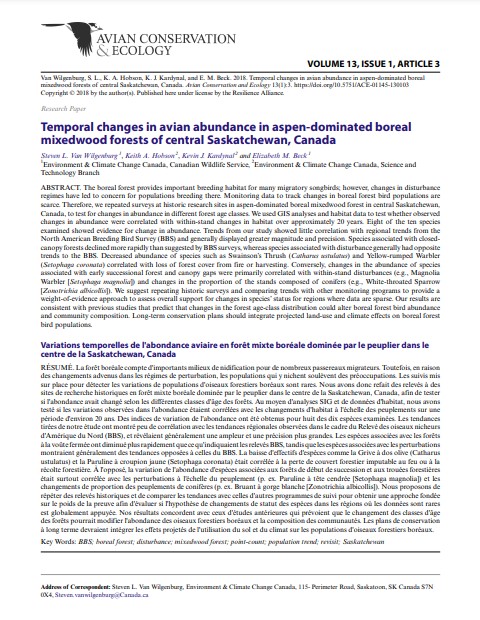Temporal changes in avian abundance in aspen-dominated boreal mixedwood forests of central Saskatchewan, Canada
Bosque Modelo:
Prince Albert
Temática:
Conservación
Tipo de documento:
Artículo científico
Resumen
The boreal forest provides important breeding habitat for many migratory songbirds; however, changes in disturbance regimes have led to concern for populations breeding there. Monitoring data to track changes in boreal forest bird populations are scarce. Therefore, we repeated surveys at historic research sites in aspen-dominated boreal mixedwood forest in central Saskatchewan, Canada, to test for changes in abundance in different forest age classes. We used GIS analyses and habitat data to test whether observed changes in abundance were correlated with within-stand changes in habitat over approximately 20 years. Eight of the ten species examined showed evidence for change in abundance. Trends from our study showed little correlation with regional trends from the North American Breeding Bird Survey (BBS) and generally displayed greater magnitude and precision. Species associated with closedcanopy forests declined more rapidly than suggested by BBS surveys, whereas species associated with disturbance generally had opposite trends to the BBS. Decreased abundance of species such as Swainson’s Thrush (Catharus ustulatus) and Yellow-rumped Warbler (Setophaga coronata) correlated with loss of forest cover from fire or harvesting. Conversely, changes in the abundance of species associated with early successional forest and canopy gaps were primarily correlated with within-stand disturbances (e.g., Magnolia Warbler [Setophaga magnolia]) and changes in the proportion of the stands composed of conifers (e.g., White-throated Sparrow [Zonotrichia albicollis]). We suggest repeating historic surveys and comparing trends with other monitoring programs to provide a weight-of-evidence approach to assess overall support for changes in species’ status for regions where data are sparse. Our results are consistent with previous studies that predict that changes in the forest age-class distribution could alter boreal forest bird abundance and community composition. Long-term conservation plans should integrate projected land-use and climate effects on boreal forest bird populations
Información Bibliográfica
Autor:
Van Wilgenburg, Steven L.; Hobson, Keith A.; Kardynal, Kevin J.; Beck, Elizabeth M.
Revista:
AVIAN CONSERVATION AND ECOLOGY
Año:
2018
N°:
1
País :
Canadá
Páginas:
-
Volumen:
13
Idioma:
Ingles
Palabras claves
boreal forest; disturbance; mixedwood forest; point-count; population trend; revisit; Saskatchewan





